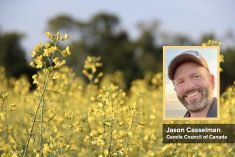[Updated Dec. 12, 2016; at bottom] – Jack Grushcow says the sky’s the limit for camelina, and he isn’t referring to the brief but well-publicized test when it was used for jet fuel a couple of years ago.
Grushcow is CEO of Linnaeus Plant Sciences, which owns Smart Earth Seeds, a company developing new camelina varieties as well as meal and oil-processing infrastructure. Smart Earth contracted 3,000 acres of camelina in 2016 at $10.50 per bushel or $11/bu. for returning growers. By 2017, Grushcow estimates it will be contracting 10,000 acres. After that?
Read Also

Sensing the soil: Root cell research finds ‘stress hormone’
Research into how root cells react to soil stressors could help plants better adapt to changes in their climate.
“I’m slow and cautious, but the market demand is going to be huge on camelina,” he says. “Important big things take awhile to build. I think this will be the biggest oilseed crop to introduce in Western Canada since canola.”
A few years ago, when camelina was first heralded as a miracle successor to canola, many western Canadian growers got burned. U.S. companies defaulted on contracts, and Grushcow says this is why he only contracts what he knows he can sell.
The value in camelina, a flowering plant in the brassica family, lies in its versatility — and its high-quality oil. Camelina seed is dense with omega-3 fatty acids and protein, and the oil, due to high levels of antioxidants, is shelf stable, unlike that of flax.
In the U.S., camelina is contracted for human food use and end uses as diverse as industrial hydraulic fluids, industrial lubricants, polyoils and polymers and the previously much-lauded jet fuel.
But Grushcow says he doesn’t believe biofuels are the strongest market for camelina. These days, he’s excited about the aquaculture industry, which has begun using camelina oil as a key ingredient in farmed fish food, and the poultry industry, which has recently received CFIA approval for camelina meal as an ingredient in broiler chicken feed.
“I was never a believer in the fact that you can grow things in Canada to burn,” says Grushcow. “You need co-products the whole way through. The meal is very important. If you can’t make money with the meal you can’t live off the oil.”

Chicken feed
The broiler chicken registration was a small but necessary step for the camelina market. According to Rob Patterson, technical director at Canadian Bio-Systems Inc. (CBS), camelina fits nicely into a niche that currently has limited options for specialized poultry diets based on non-GMO, organic or all-vegetable materials.
Along with Tofuko Woyengo and Ruurd Zijlstra at the University of Alberta, Patterson led a study that demonstrated that the nutritional value of camelina meal for broiler chickens could be substantially improved with the addition of a multi-carbohydrase enzyme supplement. This study appears in the October edition of Poultry Science.
Camelina is still in the “awareness phase,” says Patterson, but the market will grow when the laying hen registration comes through from CFIA later this year.*
Camelina is a good fit for the enriched egg market due to its high omega-3s, Patterson says. “The camelina growers and traders can hardly wait for the laying hens to be approved because that opens up a true value proposition for that ingredient,” he says.
By next year, Grushcow believes the aquaculture industry will offer a good level of guaranteed offtake for oil. By 2019, Smart Earth plans to release a Group 2 herbicide-resistant camelina variety. If Grushcow is right, camelina is — or soon will be — a safe bet for growers.
“This crop has a history of production in the human race that goes back to the Stone Age,” says Grushcow. “We’ve got a lot of interesting background on this crop. But modern breeding techniques haven’t been applied to this crop — until now.”
Breeding
Christina Eynck is Smart Earth’s camelina breeder. Her breeding program, which began in 2011, has to date focused on breeding for larger seed size and herbicide tolerance.
Midas, the variety Smart Earth currently markets, was developed in collaboration with Agriculture and Agri-Food Canada and is exclusively licensed to Linnaeus for commercial production.
Eynck says she specifically targets her breeding efforts to sandier soils. On these, they’ve seen Midas yield between 25 and 40 bushels per acre, while a new variety has shown an up to 40 per cent yield increase and up to 40 per cent increase in seed size.
The company has also developed another new variety, which has a better ratio of omega-3 to omega-6 fatty acids.
“Those two varieties are undergoing applications for plant breeders’ rights,” she says. “We will produce certified seed for the large-seeded variety in 2016, so it will be available in 2017. The other new variety will be available to grow in 2018.”
But the jewel in the crown — the most anticipated of Smart Earth’s new varieties — is the Group 2 herbicide-resistant variety for in-crop broadleaf weed control.
Currently, there are no options for in-stand broadleaf weed control in camelina; weed control has to happen pre-emergence. So the Group 2 resistance will be a game changer for the industry.
“In three years from now we’ll have the Group 2 variety, so our farmers can start to spray in-stand broadleaf weed control. That will expand our acreage by hundreds of thousands of acres,” says Grushcow.
Camelina agronomics
Colin Rosengren, one of the Three Farmers, says early camelina promoters pitched the crop as a low-input crop that wasn’t susceptible to pests and diseases and could be grown on marginal lands.
“However, we have found it isn’t a low-input crop,” he says. “It is like any oilseed and responds to fertility. We also have found camelina to be quite disease susceptible — diseases like downy mildew were impacting our yield and quality.”
The company now intercrops camelina with red lentils to mitigate disease pressure and reduce inputs.
Due to the “clean oil” demands of the healthy food market, Three Farmers no longer grows camelina on marginal land, citing the risk of weed seed contamination.
“If you are growing camelina for biofuel or animal feed then quality is not so important,” Rosengren says.
He recommends fall seeding to spread the workload, or spring seeding intercropped with lentils, and providing nutrients similar to flax. “Harvest can be challenging with such small seeds, so combine slowly to avoid losses and maybe even open the sieves a bit more and reclean after using a rotary drum to clean out the pods,” he says.
*UPDATE: The Canadian Food Inspection Agency has recently approved inclusion of 10 per cent Camelina cake in feed for egg-laying hens as well as prior approval of 12 per cent inclusion for broiler chickens.
















